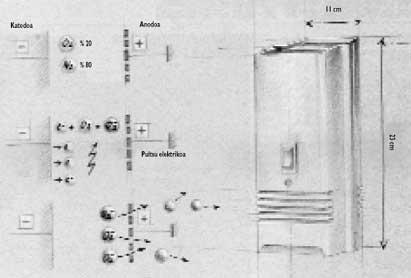Air ionizers
Those who breathe ionized air by these devices have good health and ease of sleeping well at night. All these advantages have made ionizers fashionable in recent times. The production of millions of negative oxygen ions per second ensures that these devices focus better on work, calms better and also eliminates the smell of tobacco.
Let's first look at how these ionizers work. They cut the electrical current and send short electrical pulses, generating a discharge between two electrodes each time. For discharge to occur, a transformer greatly raises the voltage between the electrodes previously. Each discharge emits a small noise so the one next to the device hears a burrundarita.
Does this pile of discharges produce millions of ions of oxygen? Yes, it creates them, just as in case of a storm it produces lightning in the air. Until the electric shock occurs and negative oxygen atoms occur, reactions occur. First, atoms located on the surface of the negative electrode or cathode during discharge present a strong thermal agitation (about 10,000°C). Due to the high voltage, the electrons of these atoms are thrown into the air at high speed between the electrodes.
The apparatus, operating at atmospheric pressure, expels the electrons into the air in the room, which collide with oxygen (O 2) and nitrogen (N 2) from the air, while the electrons located in the outer layer of these atoms are fired. The molecules lost by the negative electrical charges are positively charged, and being attracted to each other by molecules of different electric charge, the molecules N 2 + and O 2 + go to the cathode. These atoms occupy many electrons released during discharge. Electrons therefore extend into the atmosphere and, being very unstable, immediately begin to look for the molecule that collects them. These electrons are captured by oxygen, becoming O 2 - or negative ions.
According to this principle, the ionizers that sell on the market generate millions of negative ions for every cubic centimeter of air contained in the discharge, but at the same time it must be said that millions for every negative ion manufactured are without effect as before. The proportion of negative ions in the air is therefore very low. On many occasions, the device has a small fan to extend the negative ions generated to the room.
A beneficial effect of ionized oxygen is the death of bacteria. The negative oxygen molecule, like any ion, is very reactive. Quickly look for some other atom or molecule to meet and balance it electrically. When ions meet bacteria, they damage the chromosome and run out of breeding possibilities. However, since the concentration of ions is very low in the air, the number of bacteria affected is unknown.
The direct influence of these ions on the person is null. As soon as the ions touch us, they react with the first organic molecule found in the skin or in the mouth and cease to be ions.
There is also reason to say that the appliance drives away bad smells. In fact, aromatic molecules, if organic, are fractured by ions. In France, for example, about ten years ago in a seaport tried to eliminate odors, but the session was suspended because it was very expensive and inefficient.
Through ionization, some fresh foods last longer if some germs cool or die. With the bombardment of electrons, the cells inside the food are ionized, but the flavors and shapes are not altered.
Ionization is also used to remove contaminants that cannot be removed from water by classic treatments. Vacuum accelerated electrons traverse the water stream. However, when the depth of the current is greater than a few centimeters, the electrons do not reach the lower layers and the system has no extraction efficiency.
In medicine, ionization can also be used to give medicines through the skin. The area to be treated is placed in the ionized low voltage area. Therapeutic molecules are charged electrically and tend to move from one electrode to another. This technique, although initially tried to cure sports injuries, is currently used in many aesthetic centers and in some kinesitherapies. This procedure should be very careful because otherwise the products to be applied in a certain place can be extended to the whole body.

Buletina
Bidali zure helbide elektronikoa eta jaso asteroko buletina zure sarrera-ontzian











